
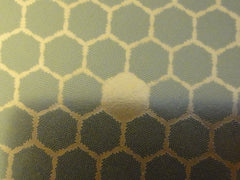
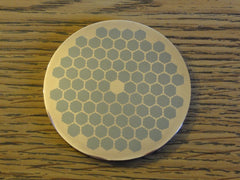

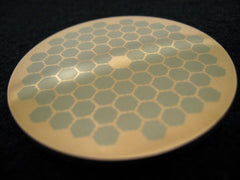
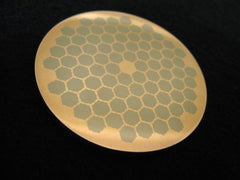
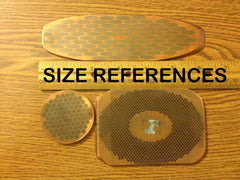

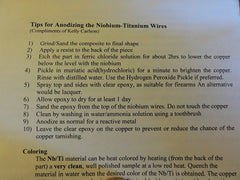
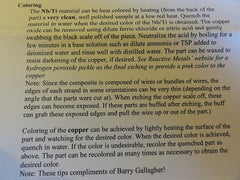
* Raw metal alloy material (see ULTRA-FINE NbTi FILAMENTS on the first detailed picture of the beehive pattern) for knife bolsters, jewelry, ornaments, etc... see pictures how to anodize it.
* Cut from the sample runs of the main conductor rods of the ex-Texas Superconducting Super Collider a.k.a Desertron that was started years ago. The project was scrapped due to budget cuts. (WIKI: https://en.wikipedia.org/wiki/Superconducting_Super_Collider).
* The piece is a slice of Niobium Titanium (NbTi) superconductor preform / half made wire for Rutherford cable. It has approx 6,426 twisted NbTi filaments with a diameter of 6-micrometers (10 times thinner than a normal human hair) embedded in an oxygen free copper matrix. Around each filament there is a 0.0005 mm layer of high-purity copper. Copper is an insulation material between the filaments in the superconductive state, when the temperature is below -263C. When leaving the superconductive state, copper acts as a conductor transferring the electric current and the heat. NbTi is a superconducting alloy. (http://lhc-machine-outreach.web.cern.ch/lhc-machine-outreach/components/cable.htm)
* Wire EDM cut.
* The coin will be sent in un-polished condition on both sides see third picture.
* Pattern: Beehive / Honeycomb.
* Coin Size (apprx.): Diameter=4.85 cm and Thickness=2.9 mm
* Composition: Niobium-53%/Titanium-47% alloy rods bundled in coppe
* Shipped thru USPS Priority mail and insured. For international purchase/shipping, pls contact us.
About SSC:
Superconducting Super Collider (SSC), a federally financed project abandoned in 1993 that would have been capable of accelerating subatomic particles to energy levels forty times that previously achieved by researchers. For reasons of national prestige and international economic competitiveness, the Ronald Reagan administration in 1982 encouraged U.S. high-energy scientists to devise a challenging national accelerator project. Physicists responded with plans for the most ambitious particle accelerator ever attempted, a superconducting super collider. It was to be a proton collider far more energetic than existing ones, employing the superconducting magnetic technology recently developed at the Fermi National Laboratory in Illinois. The primary justification for the machine was a search for particles known as Higgs bosons. The machine was to produce forty TeV protons (where one TeV, or tera-electron volt, is 1 trillion electron volts). This determined the size (a fifty-four-mile-long ring) and the projected cost ($4.4 billion). Federal funding for the machine required justification. Support from the Texas congressional delegation and the promise of $1 billion toward the project from the state of Texas led to the decision to build the accelerator in Waxahachie, Texas, rather than near Fermilab. In the autumn of 1993 the House of Representatives, faced with a more than doubled price tag, voted overwhelmingly to kill the project. By then $2 billion had been spent, the superconducting magnets had been tested, one-third of the ring had been excavated, and two teams of a thousand physicists and engineers from around the world were working out detailed designs of the two enormous particle detectors to observe and analyze proton collisions in the TeV energy range. (Cited from Answers.com)
